I’d like to introduce you to a new way of gardening. It’s called square foot gardening. I planted my first square foot garden last year and I’m hooked. Here’s the basic gist:
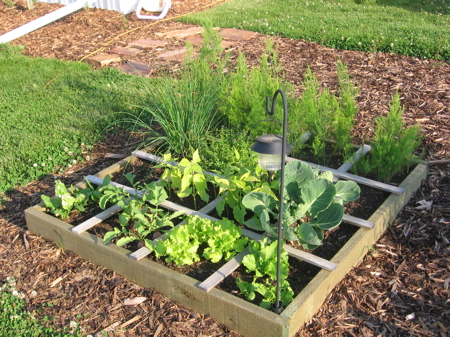 Most gardens are planted in long rows separated by three foot aisles. This means 80% of your garden (that you water, weed, and fertilize) grows nothing. You just walk on it. The square foot method eliminates that 80% of your garden that you don’t use by planting in blocks.
Most gardens are planted in long rows separated by three foot aisles. This means 80% of your garden (that you water, weed, and fertilize) grows nothing. You just walk on it. The square foot method eliminates that 80% of your garden that you don’t use by planting in blocks.
Using the square foot gardening method, you divide a 4′ x 4′ box into sixteen 1 foot square gardens. You then can plant a different crop in each of the squares. For example, you might plant 16 carrots in one box, four beans in another, and one cabbage in another. That leaves you with 13 other boxes to fill! I think it’s a fantastic system, but I’ll let you decide for yourself. Here are some of the reasons why I love square foot gardening.
#1. Perfect Dirt
It doesn’t matter what kind of soil you have, because you won’t be using it. Acidic or alkaline – it doesn’t matter. Rocky or sandy – it makes no difference. You build your own perfect soil. And it’s all really rather simple. It requires just three ingredients.
- Peat Moss
- Compost
- Vermiculite
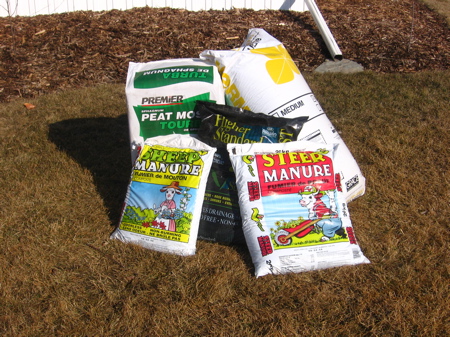 Just mix these three ingredients in equal proportions and you have the finest soil you could imagine. It’s light and loose (thanks to the peat moss), it retains moisture very well (thanks to the vermiculite), and is full of the nutrients your plants need (thanks to the compost). And all these ingredients can be found at you local garden center.
Just mix these three ingredients in equal proportions and you have the finest soil you could imagine. It’s light and loose (thanks to the peat moss), it retains moisture very well (thanks to the vermiculite), and is full of the nutrients your plants need (thanks to the compost). And all these ingredients can be found at you local garden center.
#2. No Weeding
Yup, that’s right. Since you’re making your own soil, there will be no weed seeds in there to start with. Plus, any weed seeds that might happen to blow in are easily removed because the soil is so light and loose. I think I might have pulled out five weeds from my garden last year.
#3. Less Space Required
Your square foot garden takes up only 20% of the space required by a traditional garden. That means you can be more productive with the space you have. It also means you only need to do 20% of the work.
#4. Inexpensive
I just built two square foot gardens this spring and here were my costs:
- Lumber: Free (I used scrap)
- Vermiculite: $20
- Peat Moss: $8
- Compost: $20
Total: $48 for two – $24 each.
Of course with your own lumber and your own compost, you could cut that cost down to $14 each. And once your initial garden is set up, you only need to add a little compost each year. You’ll never again need fertilizer or weed killers.
Convinced yet? Ready to build your own? Here’s how!
Required Materials
- (4) 4′ 2 x 6 boards
- (6) lattice strips (I ripped 1/4 inch thick strips off a 2 x 6)
- (8) 4″ nails or screws
- (12) 1″ nails or screws
- Cardboard, newspaper, or landscape fabric for weed control
- 60 litres of vermiculite (preferably coarse)
- 60 litres of peat moss (about 2 cubic feet compressed)
- 60 litres of compost (at least three different types – I used steer manure, sheep manure, and mushroom compost)
Building the Square Foot Garden
Attach your 2 x 6 boards together with nails or screws to form a four foot square box.
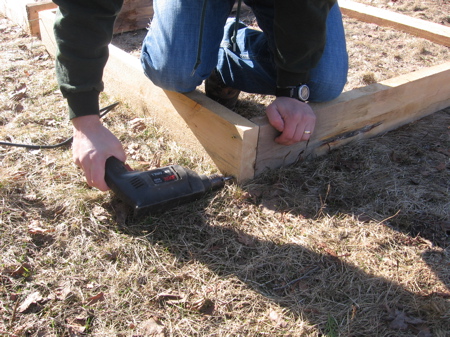
Lay down your newspaper, cardboard, or landscape fabric on the ground where you wish to place your gardens. This will prevent existing grass or weeds from pushing up into your garden. Lay your box on top of the newspaper, cardboard, or landscape fabric.
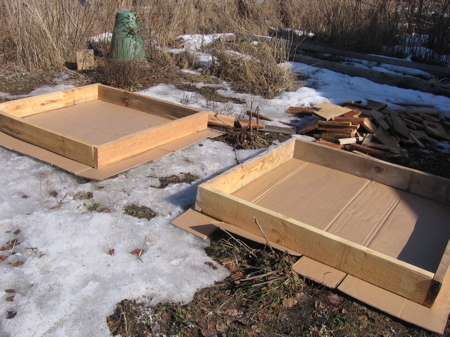
Mix the compost, peat moss, and vermiculite together in equal portions. An easy way to do this is to pile the ingredients on a large tarp and roll them back and forth in the tarp. Then carry the tarp to your garden and pour it in. (Note: You may want to water down the ingredients as they are rather dusty when dry.)
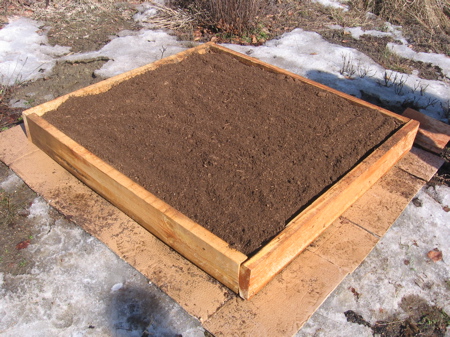
Once the soil has filled the box to the top, place the lattice on top, nailing each piece of lattice in place so that there are sixteen equal squares.
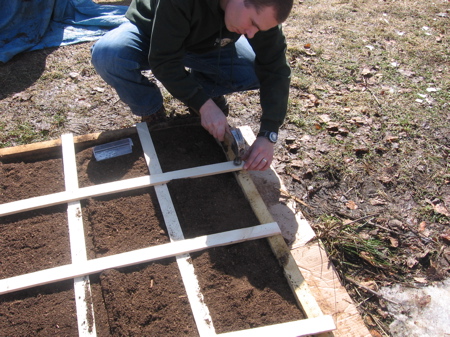
And there you have it. You’re ready to plant!
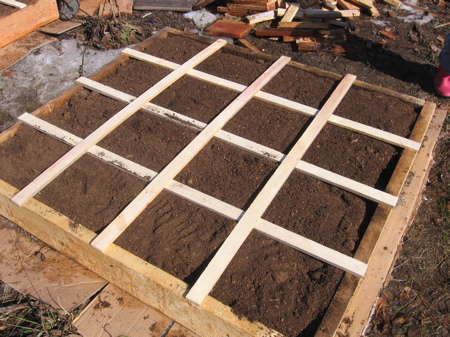
Pretty simple, isn’t it? If you’ve got any questions about how to make your own square foot garden, ask away!
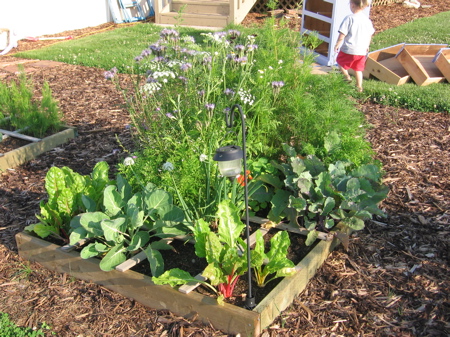
Updated: March 15, 2012
189 replies on “How to Make a Square Foot Garden”
I’ve got one raised bed and plan to build more this spring. I really like the idea of using lattice to mark off the squares – so much more sold and permanent. I’ve seen string used a lot and that seems like a lot of fiddly work to me.
I love SFG! My family has been doing it for years. A question about your lattice- what do you do when a crop takes up more than 1 SF? Like zucchini, eggplant, and some tomatoes?
Personally, I don’t completely rely on square foot gardening for everything. Things like peas, pumpkins, and zucchini I grow in a traditional garden. Tomatoes I grow in my greenhouse in raised beds.
Thank you! This looks do-able to me! I’ve never had a garden, and wondered how and where to start- this looks like the ticket. Starting with one box and trying it on for size. When do you plant it- I’m in Pincher Creek. Maybe you could recommend a site/book that would help me plan my yard- I like the idea of zeroscaping- don’t have a clue how to start- which plants, trees, etc. Thanks for your help!
-Sandy
You can plant your square foot garden as soon as you would a traditional garden. Being just south of Red Deer, I plant my garden in early/mid May. Most people around here plant their gardens on the third weekend of May.
As for books, I’ll tell you three books that I’ve found useful for my yard planning:
#1. New Complete Home Landscaping by Catriona Erler – This is a encyclopedia of everything to do with landscaping – lots of pictures for ideas.
#2. Designing Alberta Gardens by Jan Mather – This book lists many plants that grow well in our Alberta climate.
#3. Gardening Manual for Canada by Dorling Kindersley Ltd. – This one is more a how-to for everything gardening – from planting to pruning and everything in between. Lots of step-by-step pictures.
And if you want more information about square foot gardening, get the book All New Square Foot Gardening by Mel Bartholomew. Enjoy!
This looks incredibly easy (SFG); great instructions on how to build the square garden. I’m curious about the cardboard used as a base. This means the vegetable roots do not penetrate downward into the soil beneath; but remain above the cardboard growing just in the soil mix. Is this correct??
Well, here’s the cool part. Kinda yes, kinda no. Since the cardboard is biodegradable, after a while, the roots will BE ABLE to penetrate the soil beneath, but they DON’T NEED TO. You can build your SFG with a wooden bottom (with hole drilled in for drainage), and things will grow just fine in six inches of dirt.
So by using cardboard, the weeds will be killed off, the cardboard will then biodegrade, and the roots can go as deep as they like.
Do you know where in the Edmonton area I can buy coarse vermiculite? I can’t seem to find it.
In the Peavey Mart in Red Deer there are 20 litre bags of coarse vermiculite and 110 litre bags of fine vermiculite. I might guess the Peaveys in Edmonton might have it as well. I’ve actually never used the coarse stuff as this is the first year I’ve ever even seen it available – plus the fine vermiculite in the larger size is much better value for your money and it seems to work just fine.
I found medium vermiculite in the big 4 cu. ft. bags at parkland nurseries. Yes, it is a LOT cheaper than the little fiddly bags. Being also southeast of Red Deer, and planning our first SFG at a total of (gulp) 160 sq. ft., we need a lot! Did you happen to see how much of a selection of compost and manure Peavey Mart had this spring?
I tried many seedlings this year in anticipation of the garden, including some hot pink cauliflower for fun, but most did not survive the long dark week+ of that snowstorm. I had been putting them out for an hour or two of good sunshine a day up until then, and all my red onions and broccoli just kind of fell over from lack of light. (yes, my indoor light set-up was severely lacking. Better effort next year, live and learn). I still have 7 tough little pink cauliflower hanging on, though! Plan to build and transplant this weekend, all being well.
Sure is nice to see someone else doing the square foot garden thing, so close to where we live!
OMG! I made a square foot garden for the first time last year and i got so many pretty flowers growing it was da bomb. I love SFG! They make my life the best. I live off the food i grow in my SFG. I have been able to quit my job move into the country.
I planted a square foot garden several years ago to great success so I don’t know why I didn’t continue. Ironically, that’s how I’m planting my garden again this year so it was a surprise to find your post on this. My dimensions are different but the results are the same. I hope many others give it a try.
This year I’ve blended the squarefoot garden concept with the traditional long-rows garden. My garden is 30 feet wide, so I’ve run two 30 ft lengths of 2x6s four feet apart with dividers every three feet – essentially 10 blocks of twelve sq. feet each. So I have carrots in two blocks, onions in another, dill in one, beets, lettuce, etc…. So I’m able to plant a much greater volume in this space than if I had planted them in single rows. I’ll try to put up a picture or two when things start sprouting.
hello just looking over this site and glad to hear others are sfg ….this is our first year and so far it is wonderful, just had out first salad of tomatoes, greens, radish, and onions. Yummy! wonderful for a small yard with lots of flowers. i will come back to this site again. Lynda
hi there ..so glad i found out about SFG..will have it built soon. But my house don’t have a garden cause all them are filled with floor tiles so am i still able to grow vegetables using the sfg method.
Is SFG only suitable for those who has a soil garden? My garden is all floor tiles but there a big area that i can built the SFG..so can i proceed to built my first sfg?
Which types of vegetables are suitable to plant on sfg ? I would like to plant tomatoes n capsicum. I lived in asia so wheather is hot n humid most time.
thank you
Mary, you can build a sfg anywhere – no existing soil required. Tomatoes & capsicum should grow just fine. Actually, I think just about any vegetable should grow great.
Is Vermiculite safe to use. Have read it is under some scrutiny and not sure if this application would pose the same risk. I can not wait to start this garden. Awesome idea and from what I am reading it is a great way to do it.
I haven’t heard of any issues with vermiculite. Someone can correct me if I’m wrong though…
Have just discovered this site – live in Red Deer and am thinking this will be something I try this coming Spring. Great instructional photos – you’d mentioned putting up photos of your end result this year – any word on when that’s coming?
I just put in 4 4×4 SFG beds. Two things i did wrong. One, I did not wet the peat moss as i was mixing it. I am now having a hard time getting it evenly moist. Two, I bought way too much peat moss because I did not consider it expanding nearly twice it’s size.
In regards to vermiculite/asbestos scares I doubt there are any worries other than dust. There was a US plant that produced most of the world supply. It was selling asbestos contaminated vermiculite for yeas before it was discovered. I am not saying that it can’t happen again, but you should be safe as long as you wear a mask. It is simply not good to breath any dust at all.
Hi there, I just had some quick questions about square foot gardening.
I was wondering if even with the cardboard underneath, everything grows well in the square foot garden? It just seems so shallow that I wasn’t sure about deeper rooted plants – do all plants do well with this or do some do not as well?
I’m growing tomatoes cucumbers zucchini peas beans carrots and some romaine and spicy mix lettuce. will they live? lol.
and how many of each kind can be put into a sfg?
I really hope to hear back from you soon i have a tiny yard and anything to save space would be awesome and this is my first year giving it a try on my own so I’m already lost enough, lol.
Thanks for your time,
brittany
Ok, here are some quick answers… #1. Even with the cardboard, everything grows fine. Most plants only need 6 inches of good soil. If you want full size carrots or potatoes, though, I’d bump your depth up to 1 foot. (Although small carrots grow quite nice.) #2. I see no reason why any of the veggies you mentioned should have trouble growing. #3. It depends on the size of the mature plant. Radishes can be planted 16 to a foot, a cabbage head would take the whole foot. Lettuce is tight with 4 to a square. Just use the regular row spacing (should be on the seed packages) in a block.
If you need more help along the way, feel free to contact me.
What are your thoughts on double digging? we are trying it this year along with some of the sfg ideas. we double doug our first beds today and it fluffed up the soil so much that the beds naturally became raised beds without building anything and filling it with new soil. This biointensive idea sounds great, but it is based on the reasoning that since the the sub soil is loosened the plants roots grow down instead of out and that is why you can plant things really close together. The sfg spacing is the same however it does not address this idea. What do you think?
SFG’s advantage is not really that you can plant your veggies closer than usual, it just eliminates all the wasted space found between rows. The unique soil composition of SFG allows the roots to spread easily through the soil – just the same as double digging would do.
Treated lumber? or untreated lumber? I’ve read different things about it. Thanks for the great tips — makes it look so easy. This will be our first year of sfg.
Either should work just fine – treated will simply last long.
Hi there – first off, THANK YOU so much for posting this. I’ve heavily cross-promoted this on my facebook and twitter sites… I hope you get LOTS of traffic. I have a question regarding ants. The spot that is ideal for us to build our square garden is directly in the path of some nasty ants. We’ve tried for several years to deal with them but with little to no success. I’m wondering – how much of a threat are ants to a vegetable garden? I’m VERY new to this business of vegetable gardening so I have no idea. Please excuse me for asking such a wildly novice question! Thanks in advance for your help and I can’t wait to see what the next few years hold once our garden is more established.
In the places I’ve gardened I’ve never had a problem with ants, so I don’t have any first hand experience. However, if you head to this page here, http://www.thefrugallife.com/ants.html – these folks have all kinds of solutions!
If you use the cardboard method, make sure that you poke holes in the cardboard to allow water to get through. Last year I built a 4×4 raised garden bed at work and it retained all of it’s water. I had fungus growing on top of the soil, and barely anything grew. I later learned that the water needs to be able to drain out of the garden!
I attended a horticulture workshop in our community. the guest speaker suggested a recipe of equal parts icing sugar and baking soda, the ants eat it up and “explode” 🙂 place it on the ant trails or near their holes. probably have to redo it after a rainfall. I am going to try it. he is a master gardener, so he must have sucess with it. good luck
Oh wow! Thanks, Dave and Janis for this info – I really appreciate it. We’ve got the square built up so now we just need to wait for transplant time. Janis I LOVE your advice via that master gardener guest speaker! I am normally a bug/beast/all things living lover but these ants are really messing up this one spot and it’s unfortunately the only spot I have that has the perfect sun for a veg garden.
Monique, I never would have thought about the fungus bit so that’s good to know as I have already laid out the cardboard. I’ll definitely make sure I’ve provided good spots for proper drainage.
Incidentally, Dave, I used to work for the CBC (radio) and I bet they’d love to interview you about building these….any chance you’d be interested? I could send your info along to the appropriate folk…
Can you use the sfg on a patio? we live in a condo community.
Sure! Just add a plywood bottom with holes in it for drainage. You could even raise it up then. I know a lady who has several greenhouses full of strawberries that are grown in sfg-type beds all sitting on saw-horses at waist height. Makes for easy pickin’…
I’m confused do I need to punch holes in the cardboard or not? I don’t want fungus growing on top. I love this idea!
I haven’t had problems with fungus, but to be safe, a few holes certainly won’t hurt!
To the person who wanted to know where to find vermiculite in Edmonton, did you find any?
I called and located some in a greenhouse out here, which is a big deal cause it is a series of small towns….took alot of looking. So now I go out to fill my beds and realize it is a mixture of Vermiculite and Perlite. I know what Mel says about Perlite…..but I have all these bags and no idea where to find Vermicultie, so should I just use it anyways?
I’m sure a mixture of vermiculite and perlite would work just fine. Using the resources available to you is what gardening is all about!
Medium vermiculite (large, large bags) can be purchased at Apache gardening store off Stony Plain road. About 22.00 per bag.
After a ton of searching & being sold out at several stores, I found the big bags of vermiculite at Hole’s Greenhouse in St. Albert and only ~$23 with tax. Next time I’ll go straight to the greenhouse for one stop shop!
Dont use treated wood for your beds. The harmfull chemicals can leach into your dirt and produce.
I guess it would be fine if it were just for flowers.
Apache Seeds (on 149 Street, just north of Stony Plain Road) has perlite, vermiculite, compost, etc. in large bags.
FYI, there’s really nothing new about SFG — it was first popularized in a book written by Mel Bartholomew called Square Foot Gardening published in 1981 (and republished in 2005), and much of the content in this site appears to have been lifted straight out of this book. In the Edmonton area, Greenwood’s & Audrey’s usually have copies available, as does the public library.
Yup, that’s right. After I read the 2005 “The All New Square Foot Gardening” by Mel Bartholomew I was inspired to give it a try. It’s quite a bit different from the original “Square Foot Gardening” from 1981 so I would recommend the 2005 edition.
I was able to buy 110L bags of Vermiculite at Apache Seeds on 149st and Stony Plain Road in Edmonton. Also, I used Trex for my garden as it is not supposed to leach anything into the soil. I think that one could also use other composite decking materials like Azek that are made of PVC. At the end of the day though untreated wood or concrete (or stack stone) would probably be best.
Sorry, but the “Save 80% of Your Garden”-thing sounds a little off, you do realise that you still need paths around the boxes (if you don’t engineer some kind of sliding system)?
I don’t have much gardening experience so I’m also wondering why you would want to water and ferilize the soil you just walk on?
Otherwise it’s a good idea because it looks kinda nice in relation to how practical it is.
In a traditional garden, you usually have a large square plot of ground. And even though you only grow things in narrow rows, you still water, weed, and fertilize the entire thing – including the part that you walk on. With the square foot gardening system, you only water, weed, and fertilize the soil that is actually growing your plants. The paths can be mulched, graveled, or even paved if you really want!
I still don’t get why you would water and ferilize soil you only walk on, if there’s no benefits. Traditional gardeners would have picked up on that even though they use “The Old System”.
In traditional gardening you use 25% of the ground, if you have a 3 feet isle and then a 1 foot row to grow on, in a repetitive manner. You will get a better landuse if you do SFG in rows, 40% if you have one row with two 3 feet isles on both sides, and up to 57% at the most. But if you do it like on the pictures above, with isles on all sides of the box, you’ll only use 16% of the land with one box, and 19% with two.
So the system will only yeild a higher precentage if you do it in rows, and not isles around every 4×4 box like on the pictures. Having said that, the other benefits, like perfect soil, garden organisation (growing 16 carrots in one minibox and something else in another) and esthetics might compensate for the 6% land loss.
Yup, that’s true. The rows of sfg are much more efficient. That’s what I do now. In my garden now, I use one long row of sfg – about 20×4. So including my three-foot paths on both sides, I use a swath of 10 feet. To plant that same amount in four single rows with three foot paths between each would take a swath of 19 ft – almost double the space. So in there I plant my carrots, onions, beets, lettuce, radishes, and other smaller plants. I do something similar with my interplanted corn and beans. But I still use the ‘traditional’ method of rows for my peas, and potatoes.
And Perhaps I shouldn’t speak for all ‘traditional gardeners’… But in my one large garden plot, I just put out the sprinkler which waters the ENTIRE garden (including paths). I also rototill in my compost and fertilizer and whatnot at the beginning of the season ALL OVER the garden (again, including paths).
Hiya, I have just started up a site and began creating rather varied articles for it. Do you object if I write something about this blog? Of course I will provide you and this post full credit.
That sounds fine by me!
I’m trying my first SFG this year after seeing and eating the success my friend in Stony Plain had.
To the lady asking about ants, try diatomaceious earth (you can find it at greenhouses and in Canadian Tire) – sprinkle it around, let the ants eat it and haul it back to their hill and you won’t see them again. We used it inside a travel trailer and got rid of hundreds of ants that way who had made a home in the electrical wiring pathways in the ceiling.
Just a caution re handling vermiculite – keep it moist to keep dust down when mixing it up for soil or using it as a starting medium and or wear a mask – refer to the following Health Canada web site http://www.hc-sc.gc.ca/hl-vs/iyh-vsv/life-vie/garden-jardin-eng.php
I have been a SFG gardener for 5 years now and just acquired a copy of the new book called, you guessed it “Square Foot Gardening “.available at Home Depot and also Lee Valley. My Dad gave me the original book 15 years ago – took me 10 years to try it out
Have fun it works great
Jim
This looks great. What do you do to prepare your beds for winter? You mentioned adding more compost for the next year, but is there any other preparation required for reuse the next year?
Dee – That’s it. I put in enough compost to replenish any lost during the year and that’s it!
Help!!! I have tried the sfg for the past 2 years and I cant get anything to grow. I am not sure what I am doing wrong. The boxes have wood bottoms with holes drilled for drainage. I followed Mel’s formula for the soil. I have no trees in my west facing yard and so there is plenty of sun. The first year I thought maybe I did not water enough and so last year I watered more. It did not work. Very little grew,both years, and what did either produced only a handful or died. The flowers and herbs did great, but nothing else. What could I be doing wrong. I really want this to work as I have a small yard and this fits in nicely. I have many colonies of ants setting up camp in the boxes and thought maybe this could be the problem, but everything I.ve read says no. I’ve tried to elimate them anyways as they are annoying. any suggestions would be appreciated as I am planning my garden for the new year.
Thanks so much
So if vermiculite, as an insulation is a concern for containing asbestos, why would anyone incorporate this into their food source?
The vermiculite itself is completely safe. Its the traces of asbestos that is found with some vermiculite mines that is the concern. The vermiculite mine that was the source of the vermiculite insulation “Zonolite” was contaminated, but is no longer in production. All the newer vermiculite mines do testing to make sure that the asbestos levels are at a safe minimum.
Terry,
I think 6″ of soil might not be quite enough for such vegetables as e.g. carrots, potatoes, tomatoes etc.
I just came across this and I love this idea! I have moved into a home that has an absolutely massive garden area but it hasn’t been used for years and looks like an overgrown field. I was sad that I wouldn’t be able to use it this summer but with this idea I have new hope that maybe I could.
I was thinking that I could cover my existing garden plot with something like that black landscape fabric and build myself square foot garden rows. Putting the fabric on should kill all the grass and weeds underneath and then in the fall I would be able to pull off the fabric and work the ground underneath and then I could put down rock or mulch or something around my square foot gardens.
Sorry for the length of this reply, I am just excited at the possibility of being able to plant a garden this year! What do you think, does this sound like a workable plan? Do you have any other suggestions? Thanks so much!
Robyn – That sounds like a great idea! The only thing I would suggest is to make sure your landscape fabric is quite thick. Grass tends to work it’s way through the thinner, cheaper fabric. Other than that, go for it!
Why do we keep on running to the store buy buy etc. just cover the dirt with scrap cardboard and some local dirt to kill what ever is under neath that needs to be subdued.
rather than wood lattice, I use a thin line of ordinary sand, that also improves the soil over the years. Once the seeds have sprouted, the lattice is of no use, but the sand is incorporated into the bed.
Where can one find information on how to space the seeds in a sq, foot garden. I live in southern Alberta.